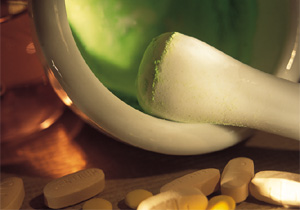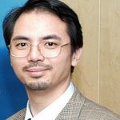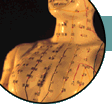|
 |
Introduction to TCM

Basics of TCM

• Yin-Yang | Five Elements

Zang-Fu Theories

• Zang Organs | Fu Organs

Classification of Antineoplastic Herbal Medicines

Characteristics of Herbal Medicines

Diagnose

• By Auscultation & Olfaction
• By Inspection

Prescriptions

Theories of Channels (Meridians) and Collaterals

Reference: A Modern View of the Immune System

Differentiation of Syndromes

• 8 Principles
• 6 Channels 4 Stages
• Syndromes of Zang-Fu Organs

Etiology

• Exogenous
| Pestilential
• Pathogenic Factors
• Emotional

Materia Medica


Back to Home

|
 |

Lung
The lung is situated in the chest, connects with
the throat and opens into the nose. Its main
physiological functions and indicators are:
(1) dominating qi and controlling respiration;
(2) dominating the dispersion and descent of qi;
(3) regulating water passage; and
(4) connecting externally with skin and hair.
It also has an exterior and interior relationship
with the large intestine.
Dominating Qi and Controlling Respiration
This function is composed of two aspects, dominating the
qi (air) of respiration and controlling respiration.
It is the organ where the respiratory air is internally
and externally exchanged; clean qi from the environment
is drawn in and exchanged for waste qi. The other aspect
of the lung's function has a close relationship with the
formation of collective (zong) qi which is the combination
of essential qi transformed from water and food with the
inhaled qi of the lung. Collective qi accumulates in the
chest, then flows up to the throat to control respiration.
Since all the blood vessels lead to the lung, collective
qi is distributed throughout the body to nourish the tissues
and organs in maintaining the body's normal functional
activities. If the lung function is normal, there is an
unobstructed circulation of qi, with even and harmonious
breathing. If there is a deficiency of lung qi, there
will be feeble respiration, uneven breathing, weak
speech, lassitude, etc.
Dominating the Function of Dispersion and Descent
The function of dispersion and descent involved
the distribution of qi, blood, and body fluid to the zang-fu organs,
the channel-collaterals, muscles, skin, and hair.
Descending function means that lung qi is clear and descends.
The lung is situated in the upper jiao (thoracic cavity) and
its qi normally flow downward. If lung qi fails to descend
and instead ascends, then the qi will pool together in the
lung and be manifested by stuffy chest, cough, asthma, etc.
The two functions of dispersion and descent,
although opposite to each other, act in unison. If the
dispersing function is not normal, the lung qi will not
flow downward and vice versa. Harmonious, downward flowing
of lung qi allows for an unobstructed respiratory tract,
uniform breathing, and provides a normal exchange of
air in the lung. In this was the lung can distribute qi,
blood, and body fluid to the entire body, transport waste
water down to the urinary bladder, transform it into urine
and excrete it.
In pathology, the two functions of dispersion and descent
affect each other. If external pathogenic factors attack the
exterior of the body, then the lung qi fails to spread.
This leads to pathological changes like cough and asthma
due to the failure of descending lung qi.
If pathogenic phlegm obstructs the lung, it will bring
about an abnormal flowing of lung qi leading to pathological
changes such as cough, fullness of chest, and gurgling with sputum.
Dominating the Skin and Hair and Regulating Water Passages
Here the skin and hair represent the entire body surface
including skin, sweat gland pores, and hire which act as
a barrier against the invasion of exogenous pathogenic factors.
In this way the lung is understood to have a close connection
with the skin and hair. Through the dispersing function of
the lung the essentials of food and water are transported to
the body surface in order to nourish the skin, hair, and
muscles. The lung also spreads defensive (wei) qi to the
body's surface, "warms the tissues between the skin and
muscles, replenishes the skin, nourishes the muscles, and
regulates the opening and closing of the pores." Therefore
the lung has the ability to protect the organic body by
defending against the invasion of exogenous pathogenic factors.
Pathologically there is an mutual influencing relationship
between the lung, and skin and hair. For example, the
invasion of exogenous pathogenic factors proceeds from
the skin and hair to the lung. The manifestations are aversion
to cold, fever, nasal obstruction, nasal discharge, cough, or
even asthma. These are signs of the lung's failure to spread
defensive qi to the body surface. If lung qi is weak and
deficient, defensive qi is not dispersed and the essential
nutrients to the skin and hair are not distributed. This not
only causes rough skin and dry hair, but also hypoactivity of
the defensive qi.
The organic body is easily attacked by external pathogenic
factors. Defensive qi controls the opening and closing
of the pores. When there is lung qi deficiency the body
surface will be weak and manifests the symptom of spontaneous
sweating. If external pathogenic cold attacks the body's
exterior the lung will lose its function of dispersing and
descending and the pores will close not allowing the formation of sweat.
Regulating the water passages means that the lung
regulates water circulation and excretion, and keeps the
water passages clear. The lung's dispersing function
circulates throughout the body the nutrients which have
been removed from food and water. Part of the fluid is
discharged as sweat and by the descending function of the
lung. Another part of the fluid is continually sent down to
the kidney and then, by the qi function of the kidney, sent
to the urinary bladder to be discharged. Thus the lung is
also known as the "upper source of water."
Opening into the Nose
The nose is the gateway of respiration. Clear,
unobstructed nasal breathing and smelling rely upon
the good functioning of the lung qi. Since the nose
is the opening of the lung, it will also be a passage
for the invasion of external pathogenic heat which may
attack the lung. Pathologically the lung also has a
close relation with the nose. For example, if external
pathogenic wind and cold block the lung, it will cause
a dysfunction of lung dispersion manifested by stuffy
nose, nasal discharge, dull olfaction, etc. If pathogenic
heat accumulates in the lung there will be nasal
discomfort caused by coarse breathing or dyspnea.
In treating this condition, the dispersing method with
pungent medicinal herbs is used to act on the lung and
nose. Acupuncture stimulation is applied on ear acupoint
"lung" to treat nasal polypus, chronic rhinitis, etc.
The above-mentioned facts demonstrate the close relationship
between the lung and the nose. The throat is also a
gateway of respiration, and a vocal organ. The lung
channel passes through the throat, so smooth qi flow
and a clear voice are directly affected by the functions
of lung qi. Hence when there is a pathological change
of the lung, it will cause hoarseness of voice, sore
throat, or other pathological changes.
Related Subjects
Read more on other Zang Organs: Heart,
Spleen,
Liver, and
Kidney.
|

|
|
|
|
|
 |

|
WHAT IS TRADITIONAL CHINESE MEDICINE?

Photo © Image DJ Image Dictionary
With over 3000 years of experience, Traditional Chinese Medicine (TCM) has
remain one of the many fascinating areas in ancient Chinese culture.
First known to be documented in the Yellow Emperor's Canon of Medicine,
TCM is believed to have been practised in as early as 475 to 221 B.C.
The field of working knowledge of TCM stretches from anything related to
general healthcare practice to the philosophy of the mind, the logic of life,
religion, and even to as far as cosmology and astronumerology. This is why
in order to thoroughly understand the concepts behind TCM, one must be
comprehensive in learning and embracing the Chinese culture as a whole.
Just as Douglas Hoff put it when he explained about accupuncture, "The systems
of TCM uses the concepts of elements and meridians and are completely immersed
in the Asian cosmology which takes shape through the religions." The meridian-brain mechanism,
the fundamental working concept of acupuncture, in which the pain block from the message
that the needle or burning cone of herbs gives to the point of stimulus,
was only found centuries later by the West through science and technology.
|
| |
|
MESSAGE FROM THE EDITOR – MARCH 2020
 Thank you for visiting this TCM and acupuncture information website.
If you have previously been to this website, you might have
noticed that some of the pages on ancient historical ideas and
holistic thinkings related to Chinese metaphysics are temporarily taken offline.
This is because I will be revamping the whole website and be moving
those information into a new \"Ancient Chinese Culture\" section
so as to reflect a more current perspective on the interpretation
of some of the fundamental concepts as well as to include
some of the latest information in the area.
But if you have just found this website for the very first time, I welcome you again and
wish you could find what you require and, hopefully, you could also be benefitted
from reading the articles I published on this website.
Thank you for visiting this TCM and acupuncture information website.
If you have previously been to this website, you might have
noticed that some of the pages on ancient historical ideas and
holistic thinkings related to Chinese metaphysics are temporarily taken offline.
This is because I will be revamping the whole website and be moving
those information into a new \"Ancient Chinese Culture\" section
so as to reflect a more current perspective on the interpretation
of some of the fundamental concepts as well as to include
some of the latest information in the area.
But if you have just found this website for the very first time, I welcome you again and
wish you could find what you require and, hopefully, you could also be benefitted
from reading the articles I published on this website.
Please be patient and do come and check out this website frequently as it's being revamped.
Raymond Cheng, PhD DPA FRSA FRSPH

March 28, 2020.
|

|
IMPORTANT NOTICE AND DISCLAIMER

 This website is published, edited and designed by Raymond Cheng,
and reflects only and only his personal views and opinions in his individual capacity.
The information available at this website is not intended
directly or by implication to either diagnose or treat any
medical, emotional, or psychological condition or disorder.
It is also not intended to create a physician-patient relationship
between you and I or between you and Wyith Institute™ and The Office of Dr Raymond K K Cheng.
The information here is not a substitute for advice and treatment provided
by your physician or by another healthcare professional.
It is always recommended that consultation with local healthcare providers
be obtained for any of your specific health or medical concerns.
Furthermore, any products that can be purchased (yet you can see I don't have much
to sell here) through advertisers' banners or through links to other websites
are not either explicitly or implicitly given any warranty or endorsement
by me, my colleagues, Wyith Institute™ or any of its associated businesses.
This website is published, edited and designed by Raymond Cheng,
and reflects only and only his personal views and opinions in his individual capacity.
The information available at this website is not intended
directly or by implication to either diagnose or treat any
medical, emotional, or psychological condition or disorder.
It is also not intended to create a physician-patient relationship
between you and I or between you and Wyith Institute™ and The Office of Dr Raymond K K Cheng.
The information here is not a substitute for advice and treatment provided
by your physician or by another healthcare professional.
It is always recommended that consultation with local healthcare providers
be obtained for any of your specific health or medical concerns.
Furthermore, any products that can be purchased (yet you can see I don't have much
to sell here) through advertisers' banners or through links to other websites
are not either explicitly or implicitly given any warranty or endorsement
by me, my colleagues, Wyith Institute™ or any of its associated businesses.
|

|
|

 This website is published, edited and designed by Raymond Cheng,
and reflects only and only his personal views and opinions in his individual capacity.
The information available at this website is not intended
directly or by implication to either diagnose or treat any
medical, emotional, or psychological condition or disorder.
It is also not intended to create a physician-patient relationship
between you and I or between you and Wyith Institute™ and The Office of Dr Raymond K K Cheng.
The information here is not a substitute for advice and treatment provided
by your physician or by another healthcare professional.
It is always recommended that consultation with local healthcare providers
be obtained for any of your specific health or medical concerns.
Furthermore, any products that can be purchased (yet you can see I don't have much
to sell here) through advertisers' banners or through links to other websites
are not either explicitly or implicitly given any warranty or endorsement
by me, my colleagues, Wyith Institute™ or any of its associated businesses.
This website is published, edited and designed by Raymond Cheng,
and reflects only and only his personal views and opinions in his individual capacity.
The information available at this website is not intended
directly or by implication to either diagnose or treat any
medical, emotional, or psychological condition or disorder.
It is also not intended to create a physician-patient relationship
between you and I or between you and Wyith Institute™ and The Office of Dr Raymond K K Cheng.
The information here is not a substitute for advice and treatment provided
by your physician or by another healthcare professional.
It is always recommended that consultation with local healthcare providers
be obtained for any of your specific health or medical concerns.
Furthermore, any products that can be purchased (yet you can see I don't have much
to sell here) through advertisers' banners or through links to other websites
are not either explicitly or implicitly given any warranty or endorsement
by me, my colleagues, Wyith Institute™ or any of its associated businesses.



 Thank you for visiting this TCM and acupuncture information website.
If you have previously been to this website, you might have
noticed that some of the pages on ancient historical ideas and
holistic thinkings related to Chinese metaphysics are temporarily taken offline.
This is because I will be revamping the whole website and be moving
those information into a new \"Ancient Chinese Culture\" section
so as to reflect a more current perspective on the interpretation
of some of the fundamental concepts as well as to include
some of the latest information in the area.
But if you have just found this website for the very first time, I welcome you again and
wish you could find what you require and, hopefully, you could also be benefitted
from reading the articles I published on this website.
Thank you for visiting this TCM and acupuncture information website.
If you have previously been to this website, you might have
noticed that some of the pages on ancient historical ideas and
holistic thinkings related to Chinese metaphysics are temporarily taken offline.
This is because I will be revamping the whole website and be moving
those information into a new \"Ancient Chinese Culture\" section
so as to reflect a more current perspective on the interpretation
of some of the fundamental concepts as well as to include
some of the latest information in the area.
But if you have just found this website for the very first time, I welcome you again and
wish you could find what you require and, hopefully, you could also be benefitted
from reading the articles I published on this website.